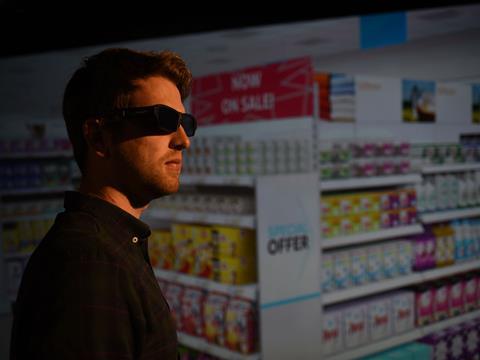
Arco Berkenbosch, vice president of innovation and development, Smurfit Kappa, explores the science behind shelf impact with Tim Sykes and shares insights from a recent whitepaper ‘Marketing on the shelf - exactly how in control are you?’ commissioned by Smurfit Kappa. He also discusses the forward-thinking ShelfSmart service, designed to reveal how packaging will perform on-shelf before it is made.
Tim Sykes:
Smurfit Kappa has been something of a pioneer in putting the science into shelf impact with the introduction of ShelfSmart. What technologies are involved in helping customers fine-tune their packaging?
Arco Berkenbosch:
Having the right combination of data, insights and tools helps create the optimal packaging solution. That’s why we have a suite of ‘Smart’ services, SupplySmart, eSmart and ShelfSmart, to deliver innovative, efficient and eye-catching packaging solutions. ShelfSmart is designed to give your packaging more selling power. Each Experience Centre is fully equipped with a Shelf Viewer tool which has an interactive touch-screen database of nearly 100,000 images from a variety of actual retail shelves around the globe. From these insights and customer understanding, we design new solutions and use pioneering technologies like the Store Visualiser to enable customers to see what their packaging will look like in store. Most importantly, we conduct research with shoppers to learn which performs best across a number of areas – brand impact, visibility and sales impact to name a few.
Tim Sykes:
Do you aggregate the conclusions of trials at these centres? Do certain best practice do/don’t rules start to emerge? Are there any broad lessons about shelf impact you can share?
Arco Berkenbosch:
The data and research collected through our Experience Centres, databases and our own analysis gives our customers greater confidence that they will see a return on their investment. With insights from over 50,000 shoppers, we can be very confident that we know what will work.
For example, many companies will apply primary packaging visual designs to the outer case but we know that shelf-ready packaging needs to follow different rules as people scan for cues in search for their preferred brands or indeed specific product features.

Tim Sykes:
Can you elaborate on the key points extrapolated from the Smurfit Kappa white paper?
Arco Berkenbosch:
There are five main points I’d like to highlight. First, timing is key, as shoppers are spending less time in store. For brands, this means that in-store packaging needs to be instantly eye-catching and differentiate itself from the competition. With insightful shelf-ready packaging, brands can have an increasing impact on how their products are displayed. One of the biggest shifts we have seen over the last few years is that consumers are spending less time in shops, putting more pressure on brands to immediately stand out in store. An average time of 12 seconds spent searching and selecting each item means that packaging that stands out on the shelf is vital for converting sales.
Secondly, brands need to explore new ways of attracting shoppers’ attention and influencing their purchasing decisions with shelf-ready packaging. The changing face of retail means that consumers are being presented with more choice than ever before. But despite being surrounded with multi-channel marketing from numerous brands, most purchasing decisions are still made in store. This means that eye-catching packaging has the potential to make a real difference. In fact, research we carried out in partnership with EyeSee revealed that 86 per cent of shoppers see themselves as ‘switchers’ and are not wedded to any one product or brand when shopping.
Thirdly, shelf-ready packaging has the potential to balance the demands of brand, retail marketing and logistics by marketing products in store and promoting a brand’s message. When done effectively, on-shelf differentiation with shelf-ready packaging can significantly boost in-store sales. Products that stand out on the shelf can also boost sales – the shelf-ready packaging that we developed for a leading food company generated a sales increase of eight per cent.
Meanwhile, there is less space in store. The rise of own-brand products means that traditional brands are competing for less space. Retailers are increasing the amount of shelf-space they give to their own-brand products, limiting the space left for branded goods. The products that do have shelf-space are therefore under even more pressure to stand out.
Finally, brands and products need to be easily identifiable to encourage repeat purchase. As consumers spend less time in store, they are more likely to pick up products that they can recognise instantaneously. Shelf-ready packaging adds another layer of recognition for branded products.
Tim Sykes:
What are the lessons learned from Smurfit Kappa’s experience with customers?
Arco Berkenbosch:
A leading food company had recently launched a new product to the market. It was highly innovative but was not selling as well as expected. Using ShelfSmart, we identified that, as most of the time and development had gone into designing the primary packaging, the product appeared small on the shelf and customers were having difficulty finding it. We designed two on-shelf options and the solutions delivered increased visibility by 31 per cent and 44 per cent respectively.

Tim Sykes:
Do you think the increase in online shopping is changing the way consumers look at and perceive items on retail shelves? Is there evidence that it is changing packaging design strategies?
Arco Berkenbosch:
It’s all about an omni-channel approach, so having an aligned brand experience across every online and offline channel is key.
The package should deliver a fit-for-purpose brand experience at every touch-point, for example, whether you are seeing the product on the shelf in a large retailer, on display in a petrol station or receiving an online order which you will unpack at home. The increase in online sales pushes the demand for alignment and highlights the opportunity to make packaging an integrated marketing tool.















